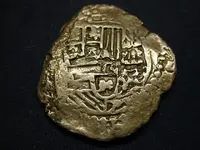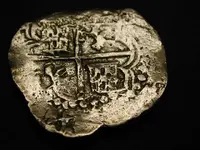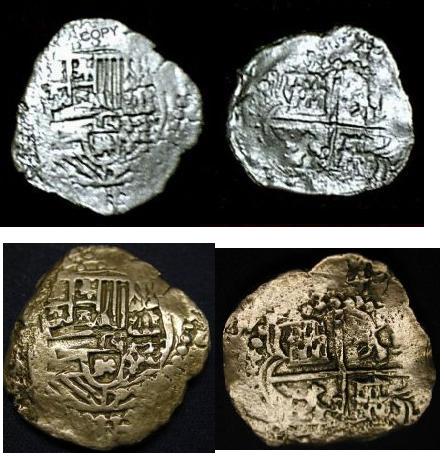For everyone else on the board, this is (yet another) Atocha-type cast replica. See another specimen of this replica below. Note the discrete pores... The weight is way low (EDIT - this IS supposed to be an 8R)considering there is relatively little "sea corrosion" (or in this case, reflecting the state of preservation of the original coin) and as Don said, there doesn't appear to be any notable clipping or edge erosion. This is Potosi; from the characteristic sloppy doubling and the lion/castle style, etc., this is probably assayer R (curved R) ca. 1605-12. Note that this was undoubtedly cast from a genuine piece; if you're thinking that the style looks off or something like that, realize that the design elements are correct and use that as a reference point in learning more about the various styles and manifestations...
NOW... Aside from that... I'm sorry you ended up with a dud here, but did my detailed and definitive (with proof) response several weeks back on the other forum not answer this?? Asking again is not going to change what it is...
coincommunity.com/forum/topic.asp?TOPIC_ID=109029
While I'm at it, from that other forum post, here are some other Spanish duds seen recently on the Bay... just to give you an idea of what's out there:
http://www.ebay.com/itm/SHIPWRECK-8...170762586793
"Grandpa's estate" strikes again. Much like the ubiquitous 1736 Lima 8 Escudo replica, specimens of this blasted piece abound. Basically a tourist replica of an Atocha-type 8R, smart a$$es like to throw them on the beach along the "Treasure Coast" and other similar areas to mess with the metal detectorists.... FYI, this is imitating a Mexico 8R, D over F, which dates to 1618, possibly 1619...... The piece is not convincing at all, with molten surfaces and semi-cartoonish detail... and and yet it brought over $150. Always boggles the mind... LEARN before you BUY!
http://www.ebay.com/itm/1760-Mexica...120841558435
A tourist shop replica that has been around for 30+ years (my Dad got one down south back in the 70's... along with one of those 1736 Lima 8E!)... Aside from generally looking like a cast, this replica is readily IDed by the conspicuous planchet crack to the rim at 3:00. The person even MENTIONS "as-is" in the listing, that they believe it's a counterfeit (though calling it a "collectible counterfeit" is deceptive, unless of course you enjoy collecting tourist shop replicas). So, what exactly do people think they're getting here? Anybody who would be willing to drop nearly 2 bills on an interesting "contemporary forgery" would clearly know better. I don't get it...
http://www.ebay.com/itm/330669973329
Atocha-type replica Potosi 8R. This needs no comment, it's so obviously a cast replica/fake... What's amusing about this piece is that the guy who ended up buying it, amusingly enough, is the jerk who buys raw (no papers) cobs which are are usually salvaged-looking, then cranks out a basement laser-printer cert (using a scanned "real" cert as his template) applying the most logical shipwreck pedigree (at least to him) for what the coin is. He's done 1715 Fleet, Vliegenthart, Consolacion, Maravillas (he likes Maravillas)... So, look for this one on eBay soon with a cert attributing it whatever wreck he dreams up, resting in a Coin World type holder with a printed tag from his basement "grading service". He gets fricking remarkable turnaround time for submissions...
http://www.ebay.com/itm/SPAIN-SILVE...110809874999
1657 Mex 8R - known Chinese fake. Some of the usual suspects listed with it...
http://www.ebay.com/itm/FELIPE-IV-1...270879161884
1657 Mex 8R - a DIFFERENT Asian fake. Had this on my suspect list from a while back (odd chopmarks, among other things); noted it as being from a Philippine seller of other definite fakes. I believe this is a 2nd specimen, based on some toning spots, though it's not impossible this could be the same exact piece (current seller bought it from the Philippines about 2 yrs ago). Either way, it's almost certainly a fake.







